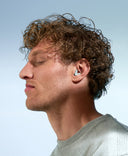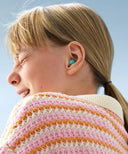Your ears are more important than you might think. Not only are they essential for hearing, but they also play a key role in maintaining your balance. Pretty amazing, right? That's why proper protection and safe care are essential. This blog post covers everything you need to know about earwax: when it’s necessary to clean your ears, and how to do it safely. We’ll also explain why cotton swabs are not recommended, and what to do if you have excessive earwax.
Function of earwax
Your ears are naturally self-cleaning. Earwax (cerumen) plays a vital role in cleaning and protecting your ears. This amber-colored substance has several important functions. It acts as a protective barrier, keeping dust, dirt, and water from reaching and damaging the eardrum and the deeper parts of your ear. It also moisturizes the ear canal. The acidity of earwax helps inhibit bacterial growth, which can help prevent infections. That’s why it’s usually best to leave earwax alone. It gradually moves outward to the entrance of the ear canal, where it can be easily wiped away.
When to clean your ears?
Your ears have a clever self-cleaning system. Still, there are times when you may want to clean them if you're experiencing the following:
-
Itching, irritation and/or slight pressure in your ear
When earwax dries out, it becomes more difficult to come out naturally. This often causes complaints such as itching. There's nothing more annoying than an itch you can't reach. Dried-out earwax can also cause a slight pressure in your ear and, over time, discomfort or blockages. You want to avoid that.
-
Excessive earwax
See a lot of earwax on your earplugs or earbuds when you remove them? You may then be tempted to remove as much earwax from your ears as possible. But you should only remove the wax that naturally comes out. Increased wax production is often a response to irritation or damage in the ear canal. Digging into your ears usually makes things worse.
-
Dust or dirt in your ears
Have you spent a long time in a dusty or dirty environment, causing dirt to get into your ears? Then it’s a good idea to clean them. But keep it limited to the outer ear and the entrance of the canal. Any deeper dirt will come out naturally with the earwax.
How to safely clean your ears
What is the best way to clean your ears? It's very simple. For everyday cleaning, use a cotton pad, a clean towel or washcloth. Lightly dampen it with warm water, wipe the outside of your ear, and dry it thoroughly. Don’t forget to dry behind your ears after showering, too.
You can also occasionally clean your ears with a specialized ear care products. For the best results, choose an oil-based cleansing solution such as Alpine Hygiene Spray. This natural spray is designed to gently cleanse and care for your ears. It hydrates the inside of the ear, softening the earwax and allowing it to come out. The Dutch Society of Ear, Nose and Throat Medicine also recommends cleaning your ears with oil-based ear care products.
Tip: Is there only water in your ear? Try this!
NEVER clean your ears like this
-
Never push cotton buds, long nails or any other objects into your ear.
-
Avoid using saline solutions, as these will only dry out your ears.
-
Do not use soap or any other cleaning products. These can disrupt the natural balance in your ear, which will only worsen your symptoms.
-
Do not spray water into your ears to clean them. The water pressure from a shower head or tap can damage your eardrum.
Are cotton buds bad for your ears?
Cotton buds are not inherently bad. However, it is better not to clean your ears with them because they can:
-
Cause damage to your ear
Inserting a cotton bud too deeply into your ear can easily cause damage. This can damage the eardrum. If the damage is minor, your body can repair itself, but this will take a few months. A larger eardrum perforation often requires surgical repair.
-
Push earwax deeper into the ear
Although many people use swabs to clean their ears, they often push wax deeper inside. This can cause blockages that affect hearing and lead to infections or other issues.
-
Cause cotton to break off or be left behind
The cotton tip can sometimes detach and stay in your ear—very difficult and unpleasant to remove. Wooden swabs, often marketed as eco-friendly alternatives, are stiffer and more likely to break inside the ear.
Suffering from too much earwax?
Here's how to remove earwax from your ears without using cotton buds. Use an active formula cleanser for fast relief. These products help dissolve wax and prevent future buildup by keeping the ear canal soft and hydrated.
Not sure which earwax solution is best? Are you experiencing symptoms like itching, irritation, pain, or pressure in one or both ears? Then it’s time to see your doctor. They can look inside your ear with a special tool to check for blockages or buildup. If necessary, they’ll treat it or refer you to an ENT (ear, nose, and throat) specialist.
This article is for informational purposes only and does not replace medical advice. Have questions about your health? Contact a doctor or healthcare provider.



